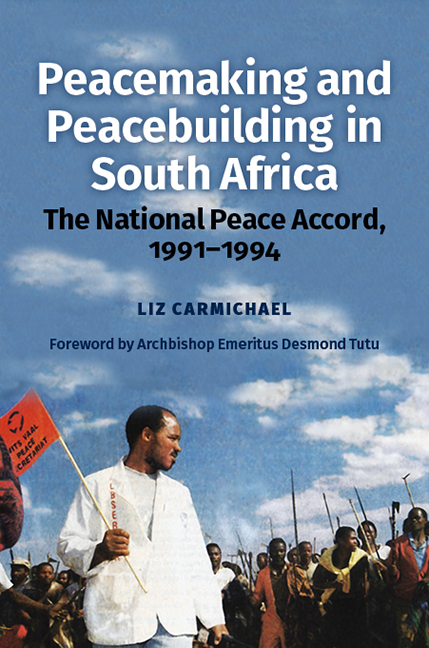Book contents
- Frontmatter
- Dedication
- Contents
- List of Illustrations
- List of Abbreviations
- Glossary
- Acknowledgements
- Note on Nomenclature
- Transition Timeline
- Foreword
- Introduction
- Part One Peacemaking, Peacebuilding, and the South African Conflict
- Part Two Peacemaking
- Part Three Peacebuilding
- Conclusion: Impact and Unfinished Business
- Bibliography
- Index
12 - National Peace Secretariat: Getting to Grassroots
Published online by Cambridge University Press: 08 October 2022
- Frontmatter
- Dedication
- Contents
- List of Illustrations
- List of Abbreviations
- Glossary
- Acknowledgements
- Note on Nomenclature
- Transition Timeline
- Foreword
- Introduction
- Part One Peacemaking, Peacebuilding, and the South African Conflict
- Part Two Peacemaking
- Part Three Peacebuilding
- Conclusion: Impact and Unfinished Business
- Bibliography
- Index
Summary
Introduction
The National Peace Secretariat (NPS), aptly described by its Chair as the ‘engine room’ of the process, was a statutory, government-funded body mandated to establish, support, and coordinate the regional and thereby local peace committees. It made immediate interventions in several ‘flashpoint’ localities while setting up eleven regional committees, each of which could establish as many local committees as needed. It developed capabilities for training and facilitation. As the organograms (p.200) indicate, it gradually absorbed the functions of communication and marketing, fundraising, and socio-economic reconstruction and development from the NPC. The NPS was attached initially to the Department of Justice because the structures were conceived as alternative dispute resolution mechanisms working with special Justices of the Peace. In April 1993 it moved to Home Affairs. It reported to the State President and NPC.
The NPS was not, as is often imagined, the secretariat of the NPC. It was its own compact, multiparty committee, a strongly task-oriented team chaired by a neutral lawyer. It was served by an administrative staff of civil servants seconded from Justice and later Home Affairs, plus others on contract, employed by the ‘Directorate of Internal Peace Institutions’ (DIPI). The NPS met weekly or fortnightly in Johannesburg, Pretoria, or a region. Members attended RDRC/RPC meetings and assisted the regions with monitoring and dispute resolution. The NPS was the point of reference for the International Observer missions, and the Chair met weekly with the Heads of Mission.
There was no command relationship between NPC and NPS. The relationship was left undefined. Jayendra Naidoo explains the fudge: ‘the National Party wanted to have more management control … through the Peace Secretariat, and I think we were a bit soft in the negotiations, we thought: “We’ll be there, we’ll manage it.” Which we did. But that left it [the NPC] kind of stranded.’ The two Chairs maintained a close working relationship, the NPS Chair attended the NPC Executive and the NPC was represented at meetings of the NPS with regional Chairs. Over time, NPC activities gravitated towards the NPS. In turn, by 1994 the regions were increasingly gaining autonomy.
- Type
- Chapter
- Information
- Peacemaking and Peacebuilding in South AfricaThe National Peace Accord, 1991-1994, pp. 236 - 251Publisher: Boydell & BrewerPrint publication year: 2022



